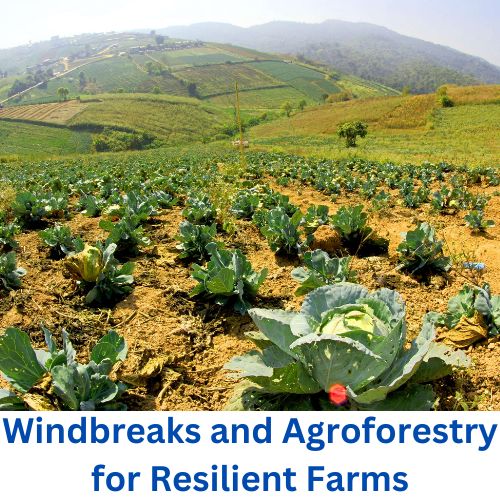“Shelter in the Trees: Windbreaks and Agroforestry for Resilient Farms” is a comprehensive exploration of how integrating windbreaks and other agroforestry practices can significantly enhance the resilience and sustainability of agricultural landscapes. This approach, deeply rooted in ecological principles, offers numerous benefits for the environment, farm productivity, and biodiversity.
Introduction to Windbreaks in Agroforestry
Windbreaks, rows of trees or shrubs planted to protect crops from wind, are a cornerstone in agroforestry. They serve multiple purposes: reducing wind erosion, enhancing pollinator habitats, and providing habitats for wildlife. Historically, windbreaks have been a part of farming practices in many cultures, protecting land from harsh weather and improving microclimates for crop growth.
Ecological Benefits of Windbreaks
Soil Conservation: Windbreaks prevent soil erosion by reducing wind speed, thereby protecting topsoil and maintaining soil moisture levels.
Biodiversity: By offering diverse habitats, windbreaks support a range of species, from beneficial insects to birds and small mammals.
Microclimate Regulation: They create a more stable microclimate in fields, reducing temperature extremes and protecting crops from damaging winds.
Windbreak Design and Management
Effective windbreaks require thoughtful design and management. The choice of species, spacing, and orientation is crucial. Ideally, windbreaks should be composed of native species, as they support local ecosystems and require less maintenance. The design must consider the prevailing wind direction, height of trees, and the types of crops being protected.
Integration with Other Agroforestry Practices
Windbreaks work best when integrated with other agroforestry practices, such as:
Alley Cropping: Planting crops between rows of trees can maximize land use and provide economic benefits while the trees mature.
Silvopasture: Combining tree planting with pasture management improves the quality of grazing land and provides additional income from timber or fruit.
Forest Farming: Growing shade-tolerant crops under the canopy of trees can diversify farm income and improve land use efficiency.
Economic and Social Implications
Economic Resilience: Windbreaks can provide additional sources of income through timber, nuts, fruits, or biomass. They also reduce crop losses due to wind damage.
Community Engagement: Windbreaks can foster a sense of community through shared knowledge and resources. They can be used as educational tools to teach sustainable farming practices.
Challenges and Solutions
Despite their benefits, several challenges impede the widespread adoption of windbreaks:
Land Use Considerations: Farmers may be hesitant to allocate valuable crop land for windbreaks. Demonstrating long-term benefits is crucial for adoption.
Maintenance: Windbreaks require initial investment and ongoing maintenance. Providing farmers with resources and guidance can aid in this.
Policy Support: There is a need for policies that encourage agroforestry practices, including financial incentives for farmers who implement windbreaks.
Case Studies
The Great Plains Shelterbelt Project in the United States: Initiated during the Dust Bowl era, this project demonstrated the effectiveness of windbreaks in preventing soil erosion.
Agroforestry in the Sahel Region of Africa: Here, windbreaks have been used to combat desertification, showing how agroforestry can be adapted to different environmental challenges.
Future Directions
Looking forward, the integration of technology in agroforestry can further enhance its effectiveness. Using GIS for planning, drones for monitoring, and precision agriculture techniques can optimize the benefits of windbreaks. Additionally, research into more resilient tree species and innovative agroforestry models is needed to adapt to climate change.
Conclusion
Windbreaks, as a part of agroforestry practices, offer a sustainable solution to many of the challenges faced by modern agriculture. They provide ecological benefits, enhance farm resilience, and offer economic opportunities. By drawing on both traditional knowledge and modern science, windbreaks in agroforestry represent a bridge between the past and the future, promoting a more sustainable and resilient agricultural system.
From Timber to Table: Agroforestry’s Contribution to Culinary Delights
Agroforestry, a sustainable land management system that blends trees with crops and/or livestock, isn’t just about ecological benefits and increased farm resilience. It also offers a delectable contribution to our culinary experiences. “From Timber to Table” showcases how agroforestry enriches the world of food, offering a palette of flavors, textures, and ingredients that make culinary delights truly exceptional.
One of agroforestry’s remarkable culinary contributions is the diversity of fruits and nuts it brings to the table. Agroforestry systems often include a mix of fruit-bearing trees like apples, cherries, or walnuts, enhancing local diets with fresh, nutritious options. These orchards add a unique touch to gastronomy, infusing dishes with the authentic taste of nature.
Moreover, agroforestry systems provide ideal conditions for cultivating specialty crops such as coffee, cacao, and vanilla. The shade provided by trees not only benefits these delicate plants but also influences their flavor profiles. Coffee, for instance, grown under the canopy of trees, develops a more complex and aromatic taste, offering coffee aficionados a rich and unique experience.
Beyond fruits and specialty crops, agroforestry contributes to culinary delights by supplying herbs, spices, and medicinal plants. The interplay between trees and herbs creates microclimates suitable for growing a wide range of culinary herbs like basil, rosemary, and oregano. These fresh, homegrown herbs elevate dishes with their aromatic essence, making every meal a culinary masterpiece.
Furthermore, agroforestry promotes sustainable livestock practices. Integrating trees into pasturelands enhances animal welfare by providing shade and shelter, resulting in healthier and tastier meat and dairy products. These ethically raised livestock products contribute to the growing demand for sustainable and humane farming practices.
“From Timber to Table: Agroforestry’s Contribution to Culinary Delights” represents the fusion of agriculture and gastronomy. It highlights how agroforestry systems offer a cornucopia of natural ingredients that chefs and food enthusiasts can explore to create exceptional dishes. Beyond the plate, agroforestry embodies the idea that sustainable agriculture can be a source of culinary inspiration, bridging the gap between our taste buds and our commitment to the environment.
